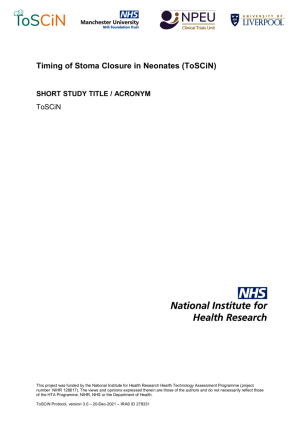General Information
Background
Neonates undergoing emergency surgery on their abdomen frequently require stomas to be formed. Whilst stomas can be life-saving, they pose a number of challenges including fluid and electrolyte imbalance; local wound and skin problems; malnutrition and growth failure. Reversing (closing) these stomas with a second operation is therefore an essential part of the infant's recovery. The timing of this closure is known to be highly variable and the best time to do it remains unclear, with conflicting evidence from published studies and reviews.
Determining the best time to close stomas in neonates is imperative as it has significant implications for their short- and long-term health outcomes, as well as their families and health providers. Reducing unwarranted variability in surgical care is also a key priority for the NHS.
Determining the best time to close neonatal stomas would require a clinical trial, but such a trial would likely to be highly challenging due to the wide range of underlying diseases and co-morbidities in the patient group. It would also be important to know whether parents are willing to enrol infants on such a trial, and whether clinicians are willing to recruit to it.
Objectives of the study
ToSCiN aims to answer the question: is it feasible to conduct a clinical trial comparing 'early' vs. 'late' stoma closure in neonates?
Its objectives are:
- To establish current UK practice for stoma closure in neonates
- To determine whether there is equipoise amongst clinicians (neonatal surgeons, and neonatologists) and allied health professionals (specialist nurses and dieticians) over when it is best to close stomas in neonates
- To define 'early' and 'late' stoma closure for a potential trial.
- To define a population of neonates for inclusion in a trial (in whom there is significant uncertainty over timing) and determine how many infants are eligible for inclusion.
- To establish the most appropriate design and outcome measures for a trial.
- To determine the willingness of parents, neonatal surgeons and neonatologists to include neonates in a trial that would randomise to 'early' or 'late' stoma closure and identify potential barriers to recruitment.
- To assess the suitability of using routinely collected data for gathering clinical information for a trial.
Structure of the study
ToSCiN is made up of three workstreams:
- Workstream 1 was an online survey of clinicians and allied health professionals from neonatal surgical units across the UK involved in the care of newborn infants requiring formation of a stoma. This workstream has finished collecting data, which is being analysed
- Workstream 2.1 is an observational cohort study of neonates who have had a stoma formed, and it will aim to recruit 30-40 neonates
- Workstream 2.2 is questionnaires sent to the principal clinicians (surgeon and neonatologist) caring for the neonates recruited to Workstream 2.1
- Workstream 2.3 is a qualitative study involving focus groups with clinicians, interviews with parents of neonates recruited to Workstream 2.1, and interviews with parents of children who have had a stoma in the last three years. All qualitative work at present will be via telephone or videoconference
- Workstream 3 is analysis of three existing databases (the National Neonatal Research Database, the Health Episode Statistics dataset, and the British Association of Paediatric Surgeons Congenital Anomalies Surveillance System) in order to establish current UK practice, define a population for trial inclusion and the number of eligible infants, and identify appropriate trial design and outcome measures
The output of the three workstreams will be amalgamated and used to inform a one-day trial design consensus meeting at the end of the study. The aim of the meeting will be to gain agreement on aspects of design and conduct of a future trial.
For more information on ToSCiN, please download the protocol below or contact the Study Coordinator, Madeleine Hurd, at toscin@npeu.ox.ac.uk.



